It’s been 14 months since the City of Portland took the keys to 82nd Avenue away from the Oregon Department of Transportation. This jurisdictional transfer has been hailed by community leaders and advocates as a way to transform the former state highway into a more pleasant main street with better transit service and more safe places to walk and bike.
With $185 million already committed to the plan, PBOT and their partners at Metro and TriMet have begun to set the foundation of what 82nd will look like when all the dust settles in 2030. As with any project like this, a big part of the process is public outreach. And Tuesday night at McDaniel High School project leaders hosted the first of three district workshops. It was the north district workshop, with similar events for the central and south districts coming next month.
Curious about where things stand with this project, I rolled over to check it out.
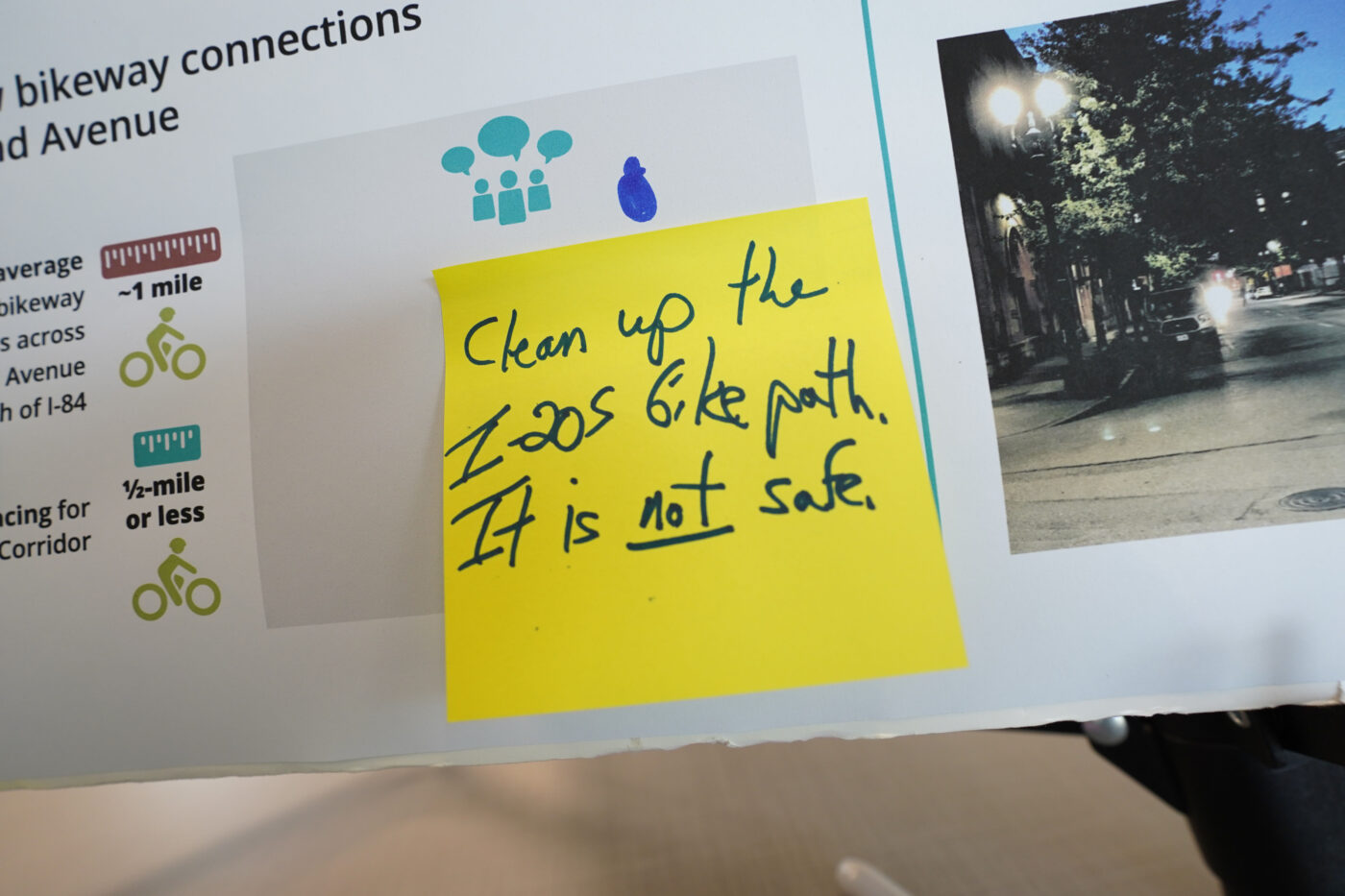
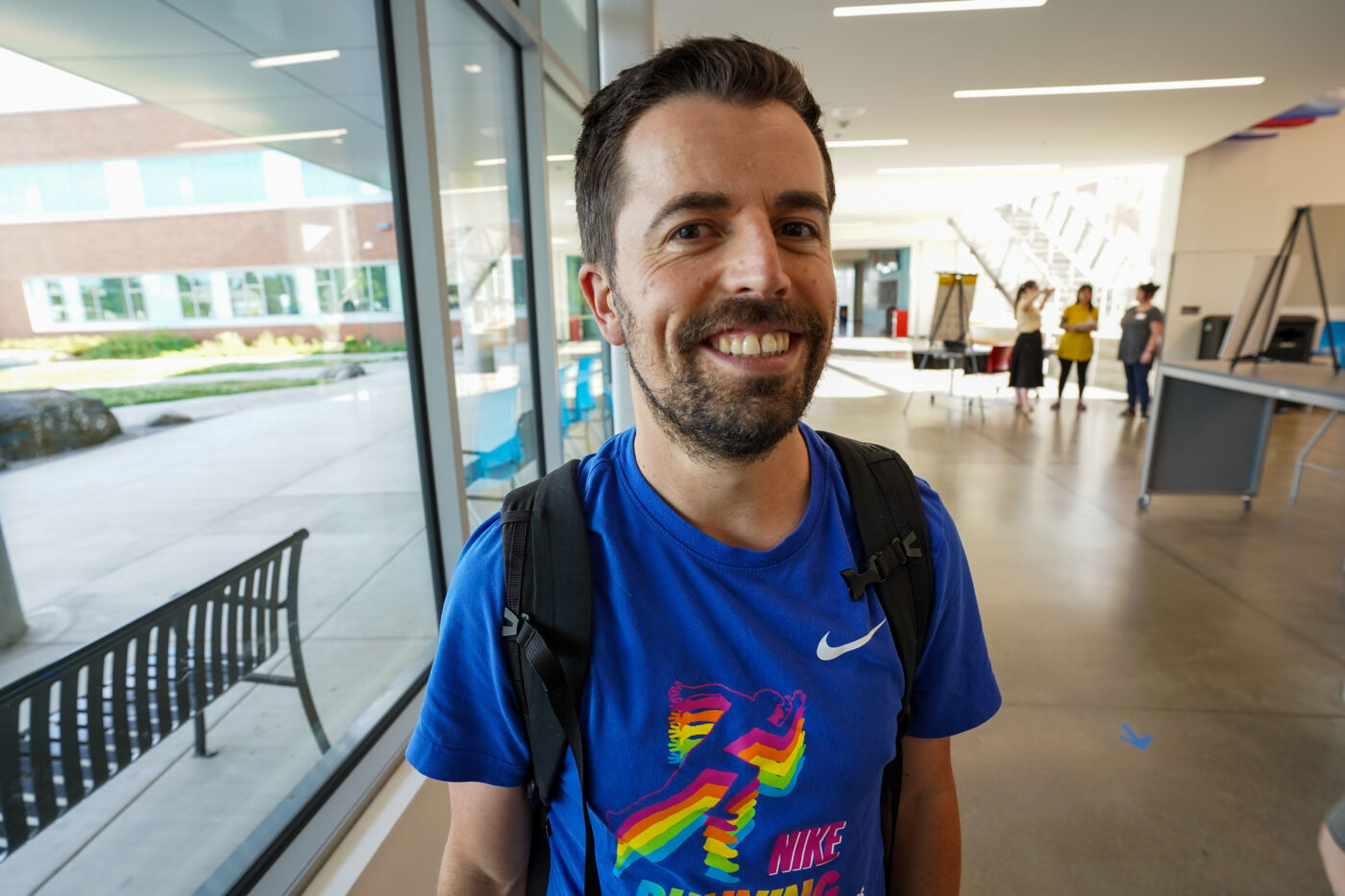
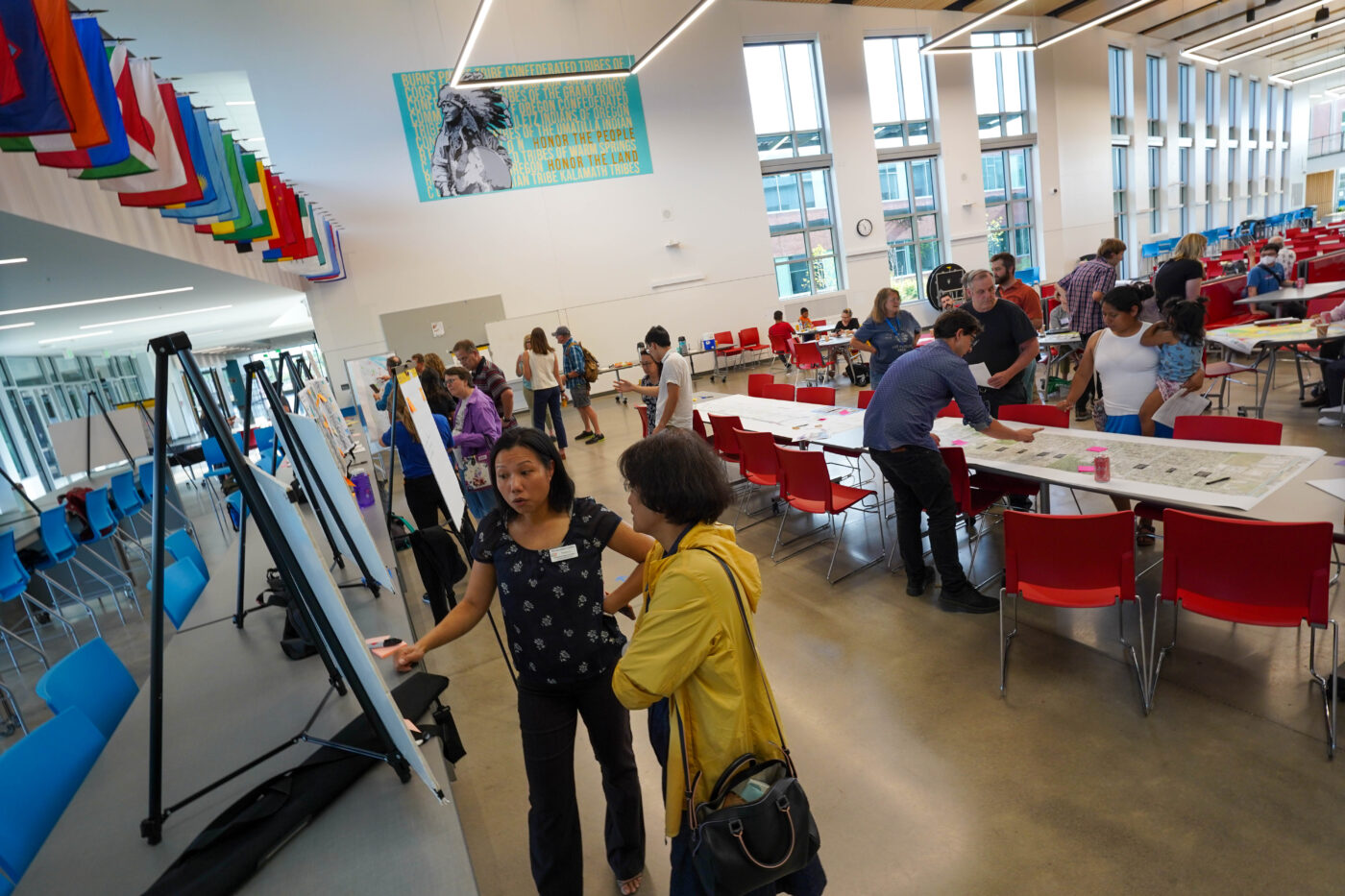
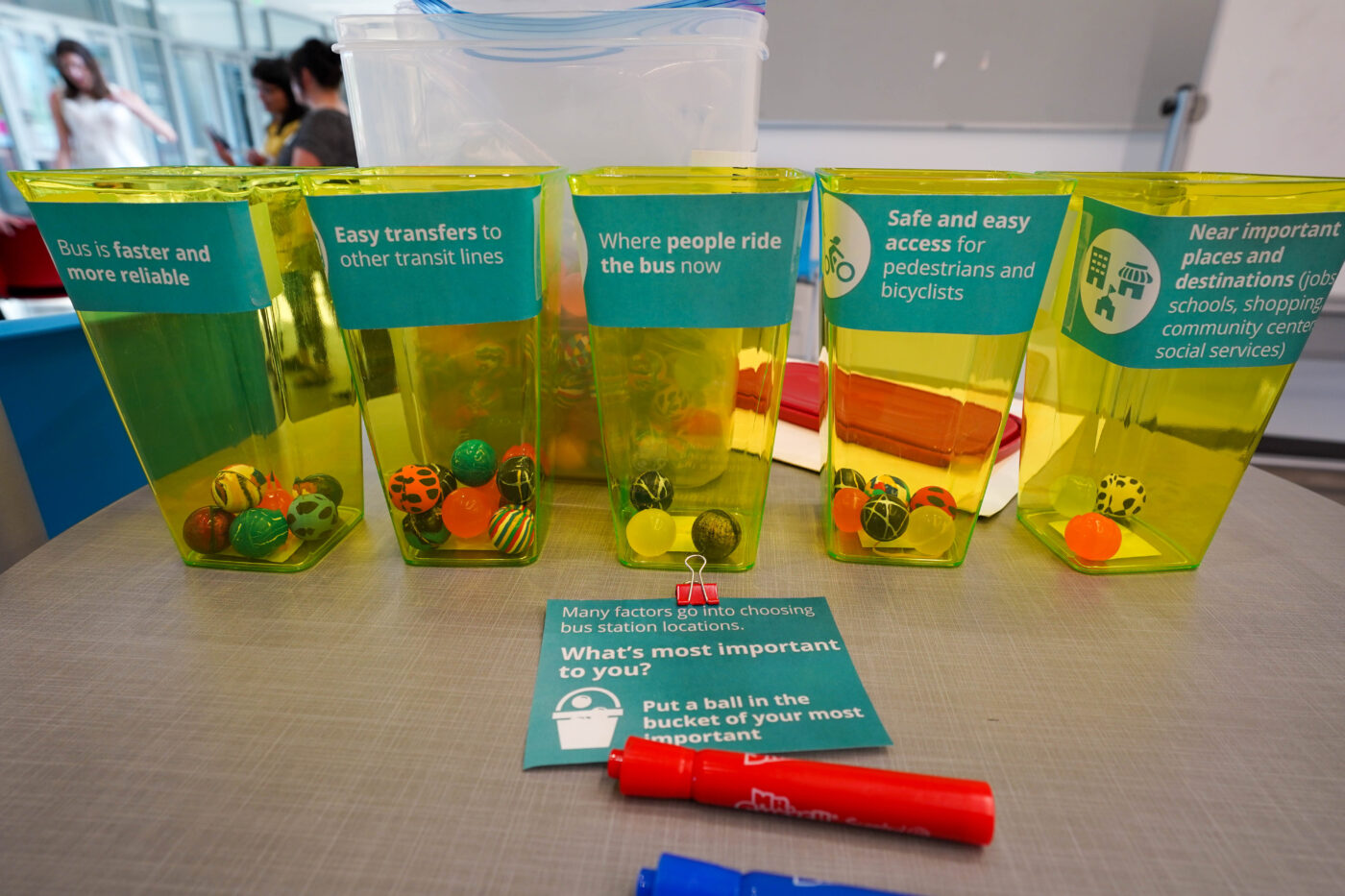
It was a relatively good turnout for a weeknight transportation project, but I bet over half the crowd were agency staff, professional advocates and/or consultants who were paid to be there. There was a loop of posterboards where folks could see project details and lots of Metro, PBOT, and TriMet staff available to answer questions. Folks were chatting at tables and filling out post-it notes with their comments. One of the first people I ran into was Micah Meskel. Turns out he’s the Interim Urban Conservation Director for Portland Audubon, so it was no surprise our chat centered around the role of trees in the future design of 82nd.
Asked what his focus for this project is, Meskel said, “Trees are a top priority, especially using them to create safer pedestrian access and traffic calming.”
It’s not just conservationists like Meskel who are thinking about trees. Given their ability to reduce the heat island effect (and myriad other benefits) they are one of the project’s top priorities and they appear in medians in the earliest conceptual designs.
How would Meskel balance the preservation of trees with a safer street design? “We know that existing trees are so much better at suppressing carbon, creating shade, and all that stuff. And yes, sometimes they come in conflict with the best design. And so it’s sort of a case-by-case basis,” he replied. “I start in the position of ‘let’s see how we can work around the tree,’ and so whether that’s realignment of the sidewalk or whether that’s thinking of loosening the standards at one pinch-point spot.”
Along with street trees, the project laid out other priorities last night: a vibrant streetscape, safety, and bicycling.
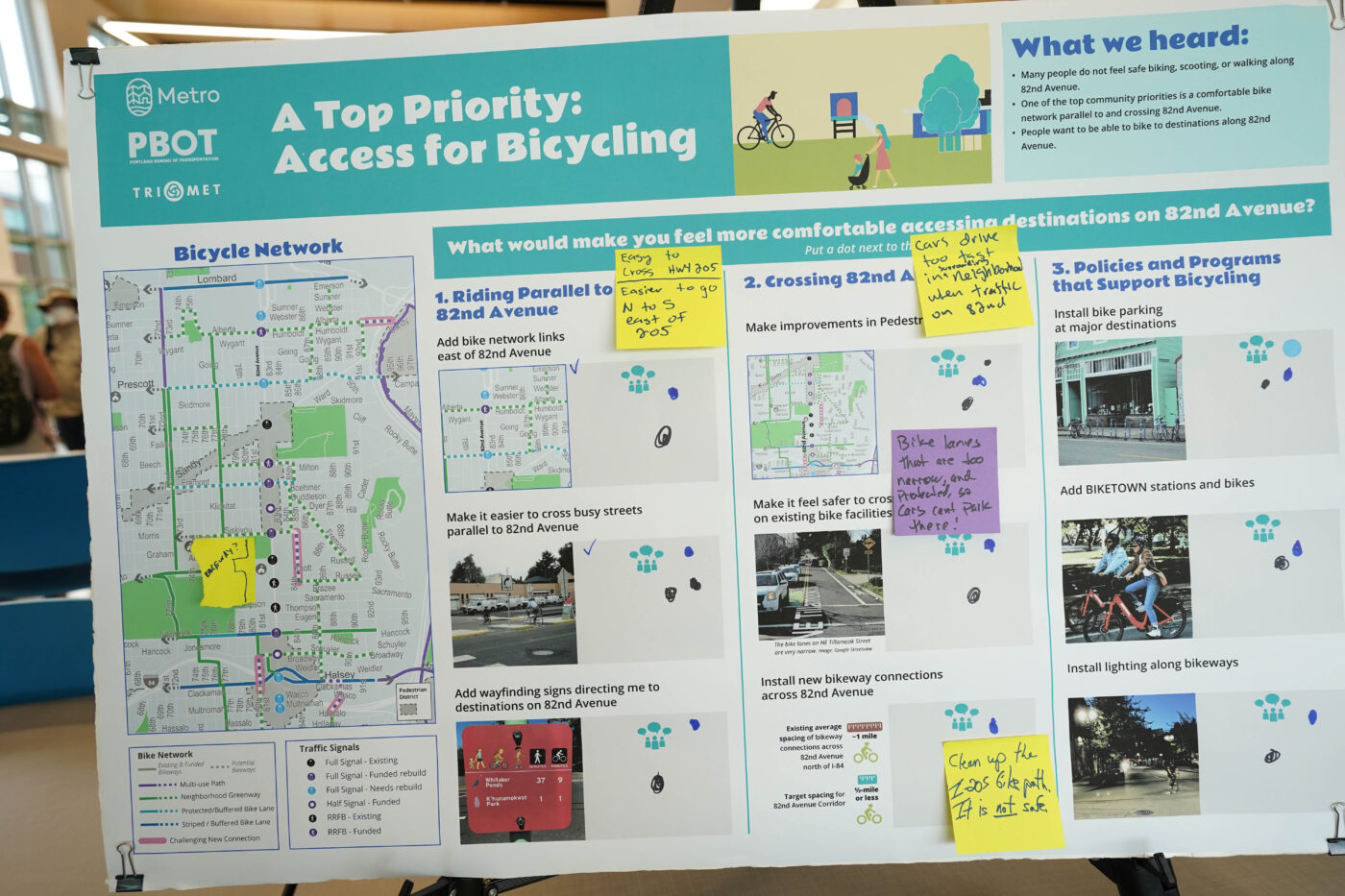

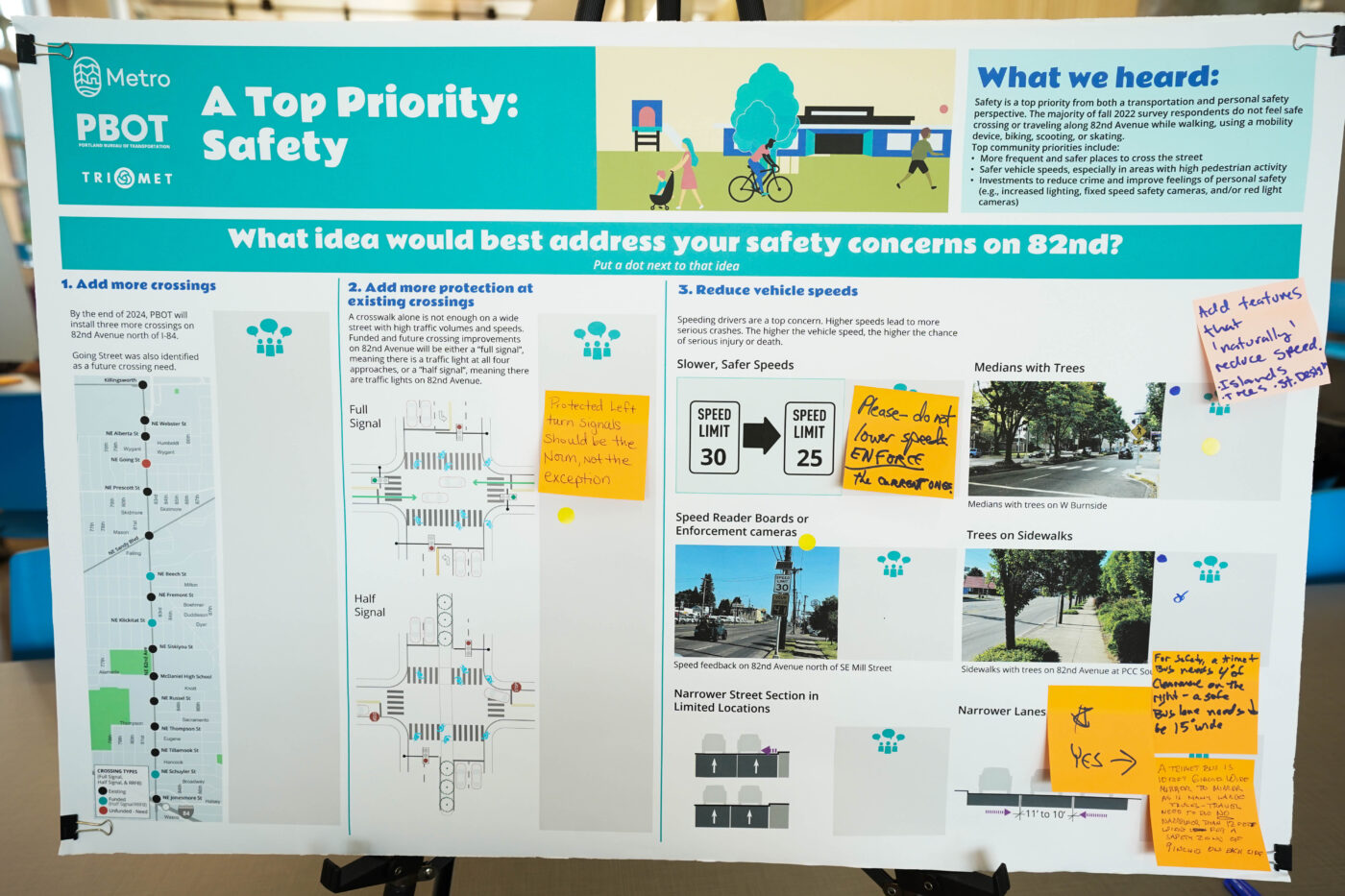
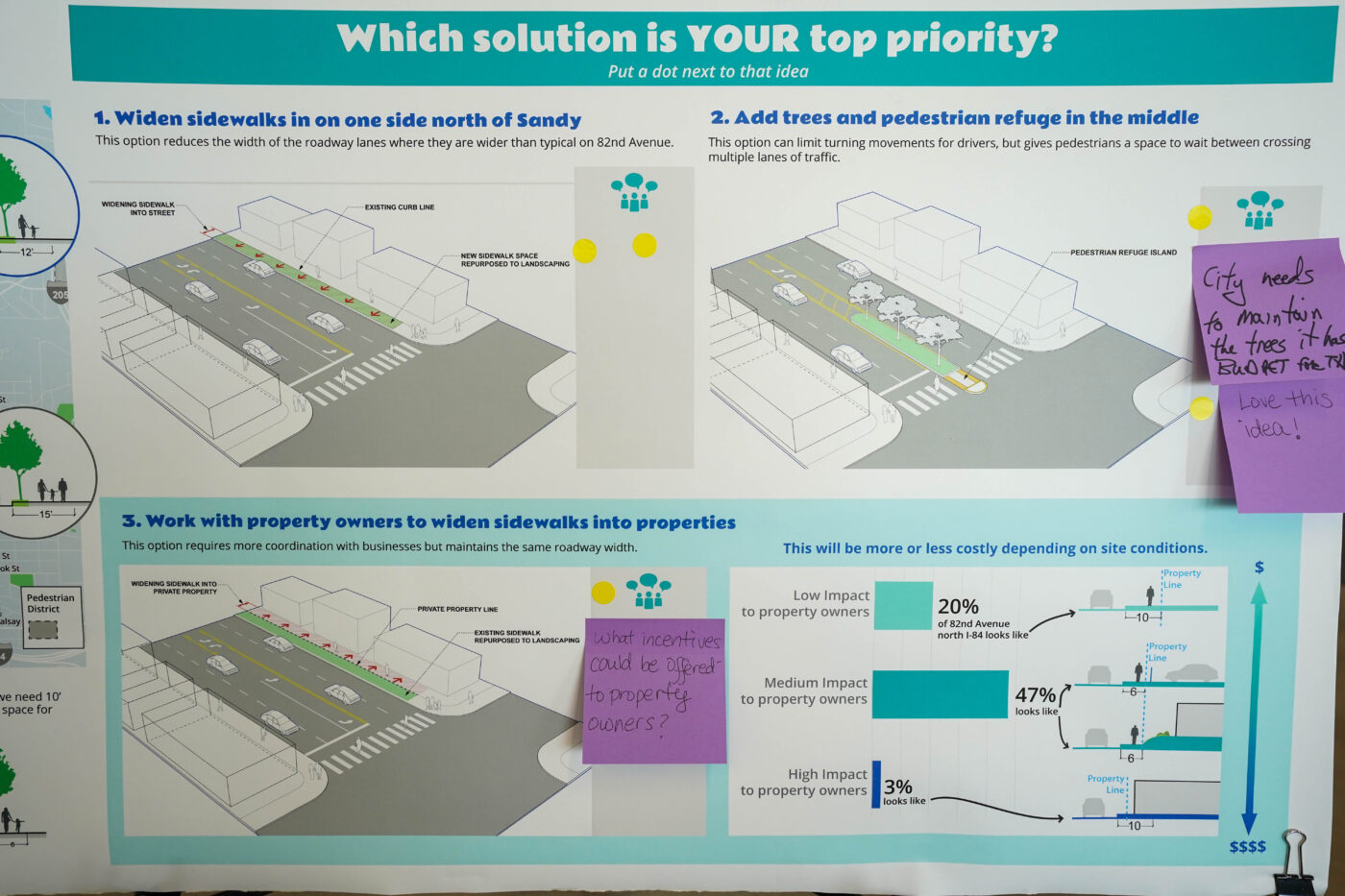
While this might sound like conceptual fluff, you’ll be happy to know that work on 82nd has already begun in earnest. PBOT has a list of critical maintenance needs and crossings they’re working on. By 2026, they say, they will have invested $101.6 million into 82nd Avenue. A lot of that money is going into repaving. PBOT expects 46% of the street between Lombard and Clackamas Town Center to have fresh, smooth pavement by the end of 2026. Also in the next three years, they promise to: complete all new street lighting needs; add 23 new or updated crossing treatments; and to replace and modernize nine traffic signals.
While they work on those immediate needs, gears are already turning around the larger discussions like lane reconfigurations, bikeways, and future transit service. The goal is that by 2030, the transformation — including new paving, full ADA compliance, new bus service, wider sidewalks, bikeways and other upgrades — will be complete.
The nature of the transit service and how bicycling and driving will figure into the project are still very much up in the air; but initial conversations that will shape these important outcomes have begun.
TriMet Project Director Michael Kiser, fresh of leading the Division Transit Project, was hanging out at the TriMet posters. Asked what type of transit we can expect on 82nd, and whether it be like the FX line on Division or something better, Kiser was coy. He didn’t want to step on any toes. “I’d like to say, ‘We did Division, now let’s go bigger’ But we don’t control the right-of-way and want to work with our partners.”
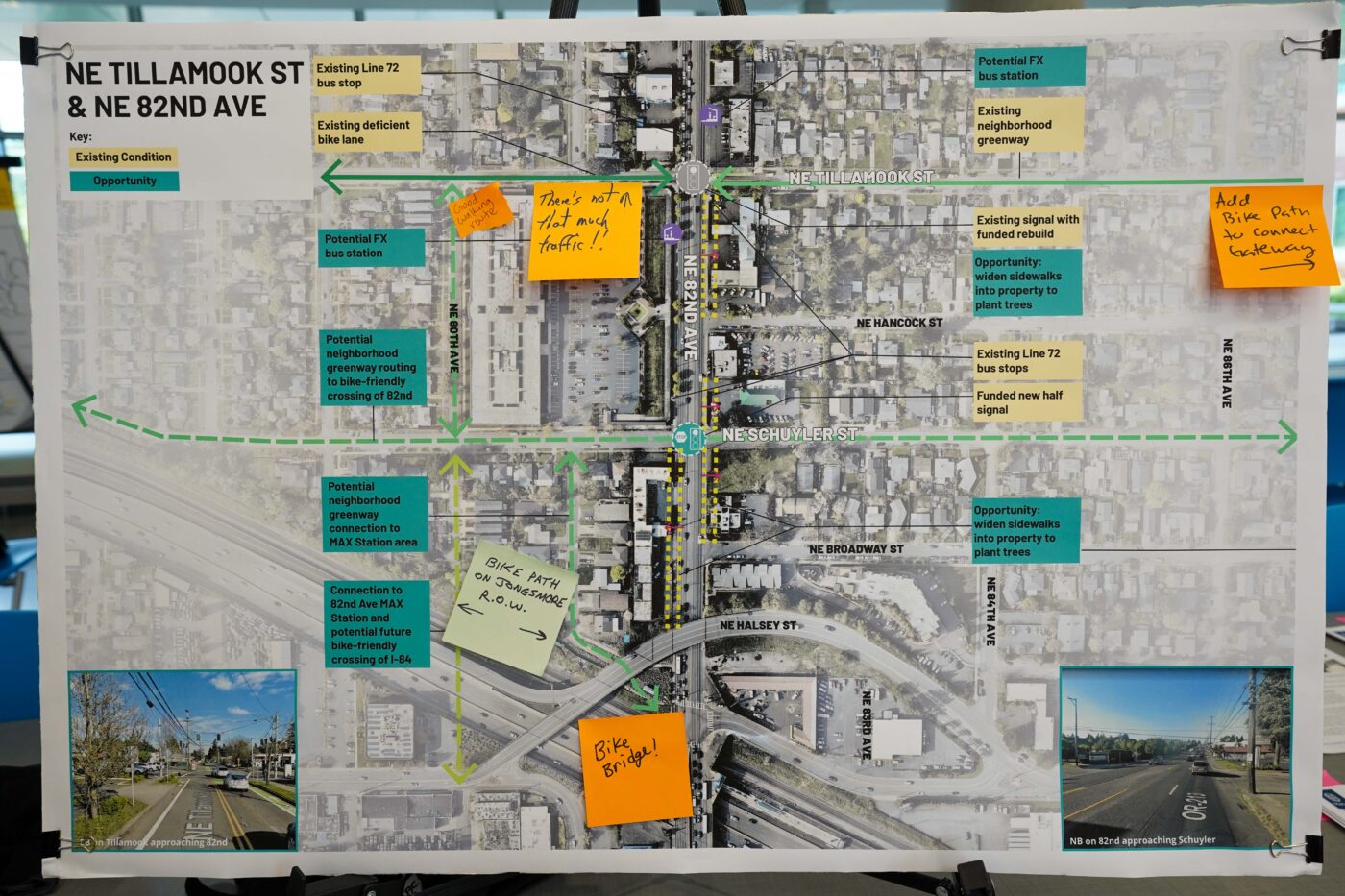
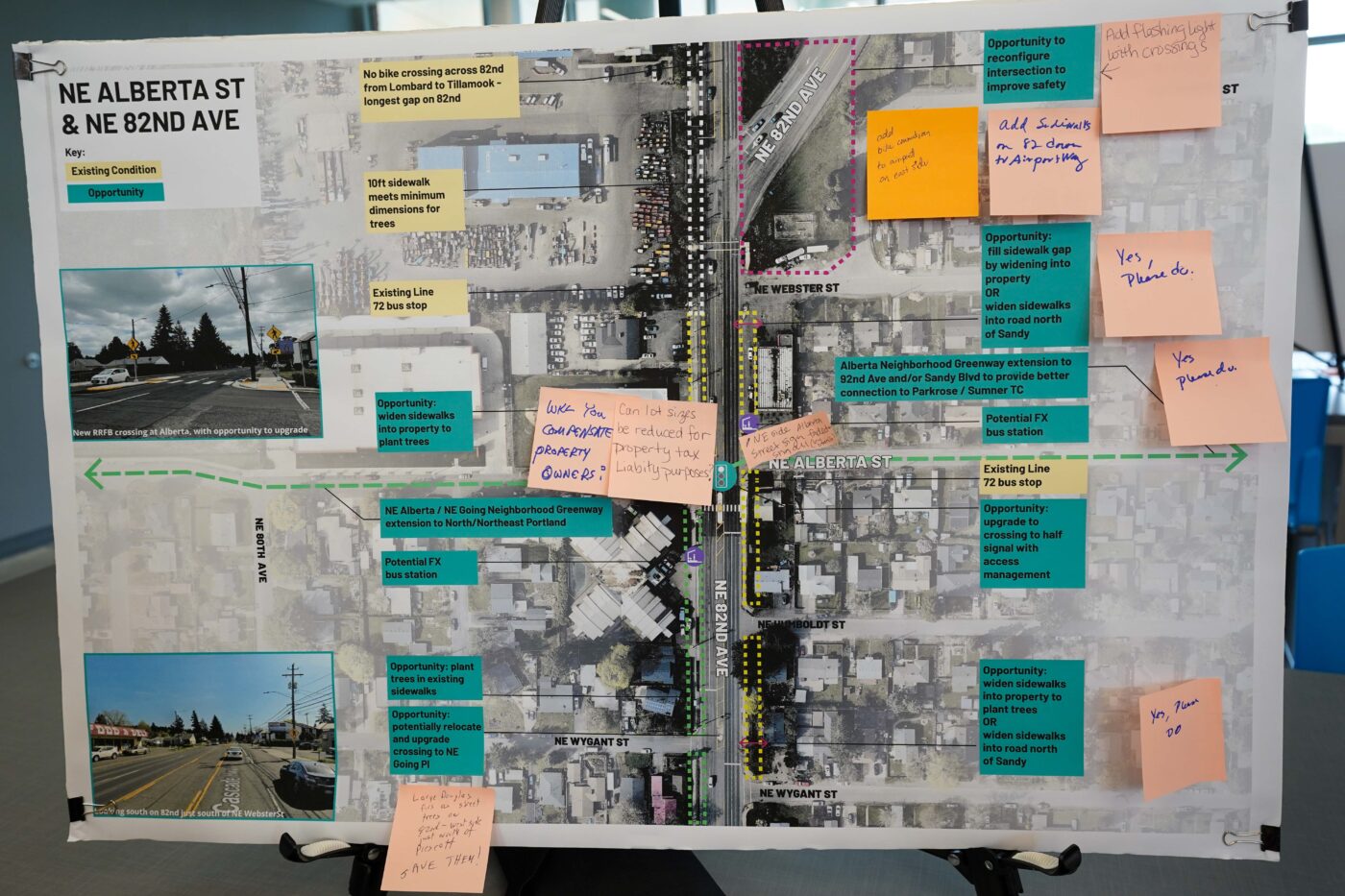
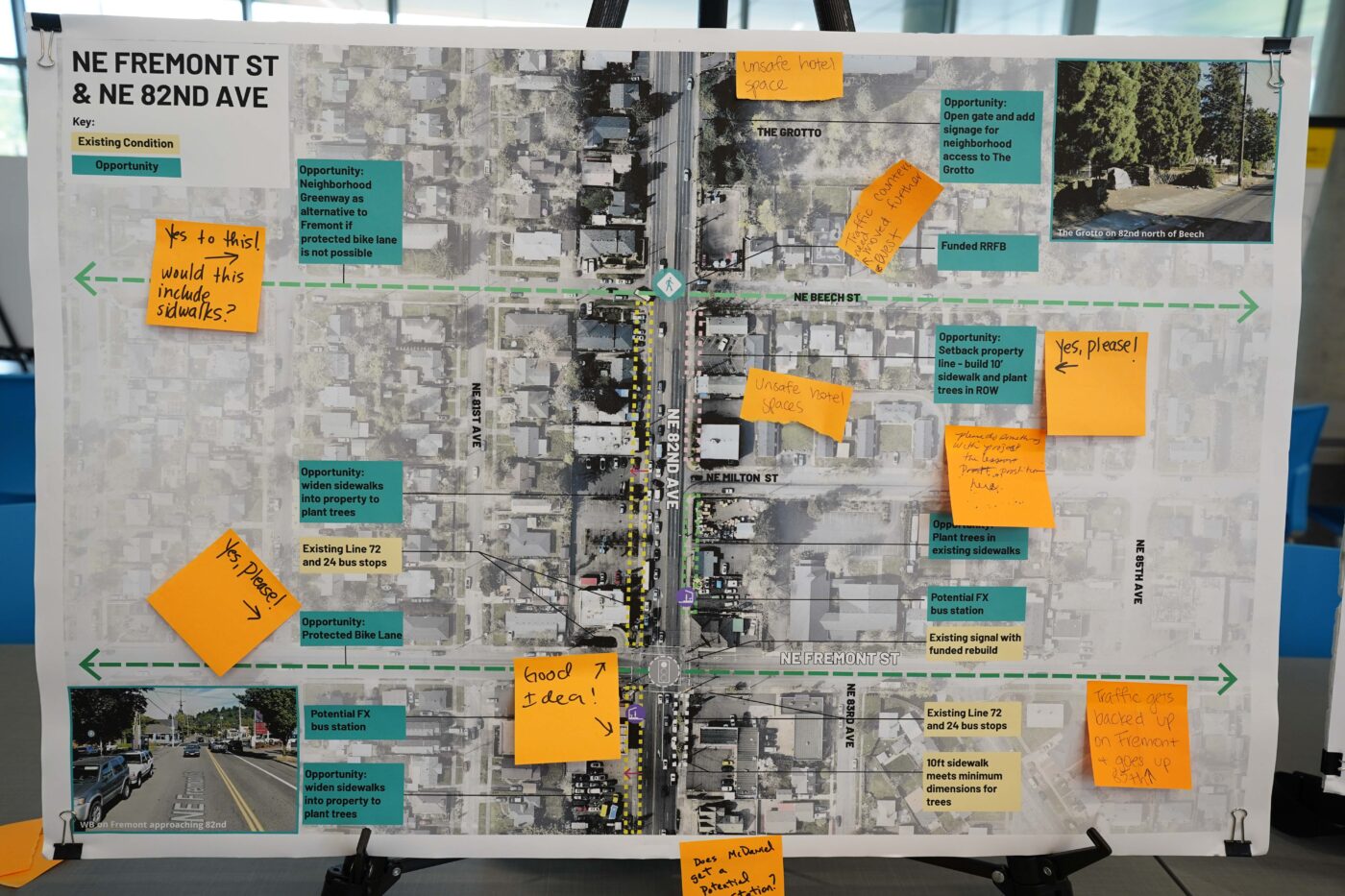

It’s assumed that bus service will get much better as part of this project. It’s also assumed that car users will have access to the street. Interestingly, the same can’t be said for bicycling access. Currently, 82nd is a classic, five-lane arterial with two standard lanes and a center turn lane. The current thinking is to use two of those lanes for buses, add a bunch of center median islands, and keep two lanes for drivers.
I haven’t heard anyone talk seriously about a dedicated bike lane on 82nd Ave at this juncture. I’ve been hearing things like, “We can’t fit everything,” and “The community still wants/needs to drive.” It will be an interesting choice — given the climate crisis and our stated goals to reduce driving — if we exclude bicycle access and maintain car access on such an important corridor.
There’s a lot of talk about improving parallel routes and east-west connections to 82nd; but not only would that not equate to easy and direct bicycle access, there will likely be no guarantee of funding to do those projects. I think we’ll need to get very creative and we should not shy away from the difficult conversations about the type of city we want to build and how driving and cycling play a role in that.
I was happy to hear from planning staff last night that at least there’s recognition of the importance of bike access beyond the chorus of folks already capitulating and saying, “let’s just make a good neighborhood greenway” somewhere nearby. On some (albeit very few) sections of 82nd it might be possible to widen the sidewalk and create a shared bike/walk facility, or even a multi-use path.
If we end up with no bikeway on 82nd (the most likely scenario given current politics), the next best thing might be to make sure the new bus lane explicitly allows bicycling. If designed properly, a shared bike/bus lane on 82nd might be a good outcome. On that note, if we do our job taming and reducing car traffic, there’s a percentage of biking Portlanders that might even feel comfortable sharing the non-bus lane with car drivers for a block or two (much like folks do now on streets like Hawthorne and Alberta).
It will be fascinating to see how this conversation evolves in the coming months and years. One thing I learned last night that will make it even more interesting is that the Oregon Department of Transportation still owns three portions of the street: the northernmost section from NE Alberta to Lombard, the bridge over I-84 and the area around the MAX station, and the SE Powell Blvd intersection.
If you want to learn more about this project, I recommend checking out one of these workshops. There are two more planned for July 20th (center district) and 29th (south district). Find out the details at PBOT’s Building a Better 82nd project website.
Take a tour of the posterboards in the embedded PDF below:



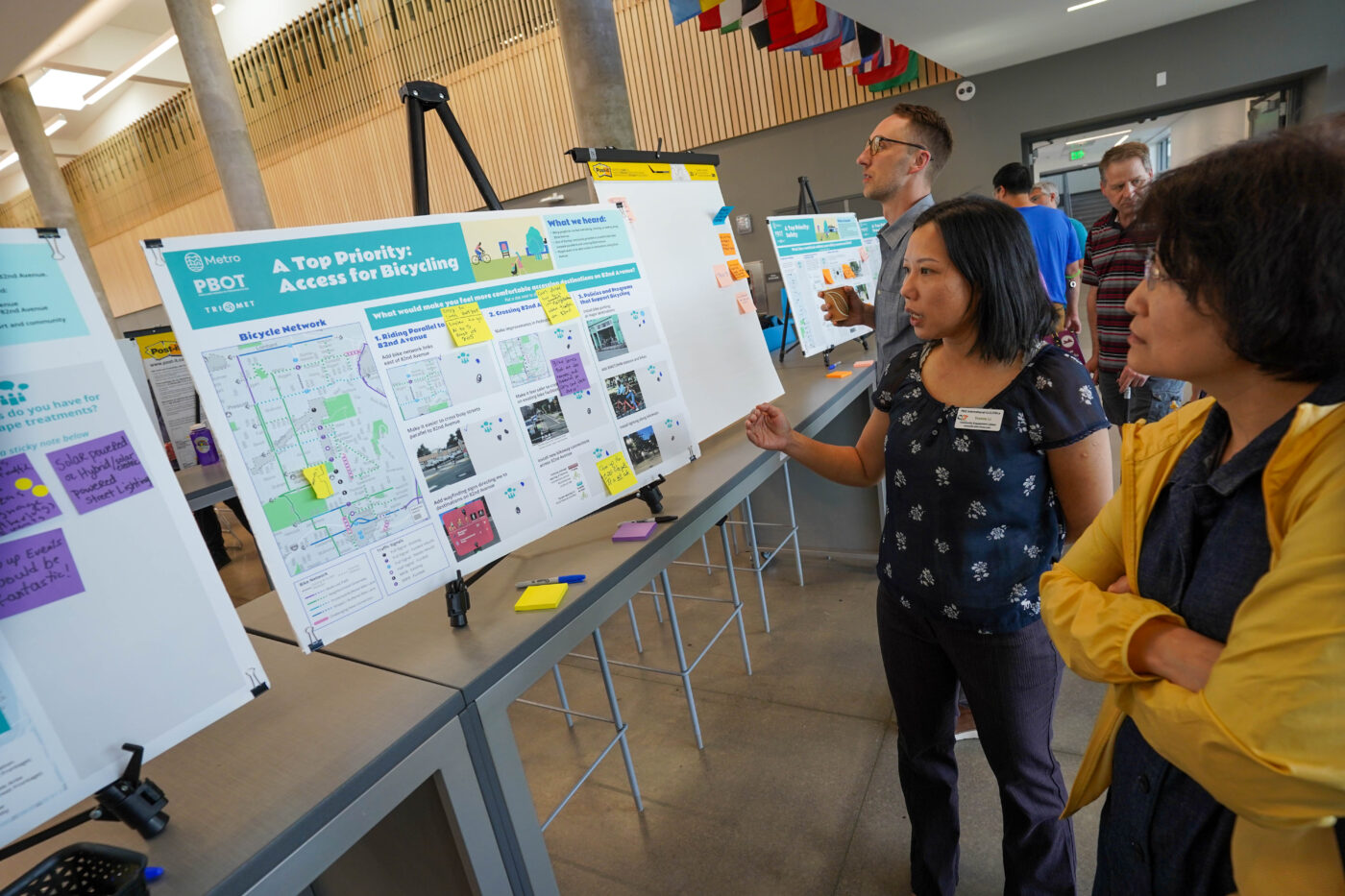
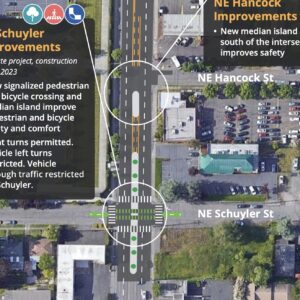
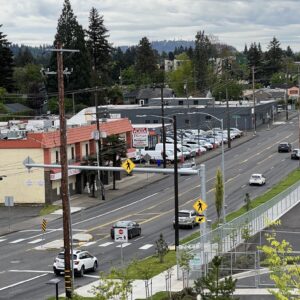
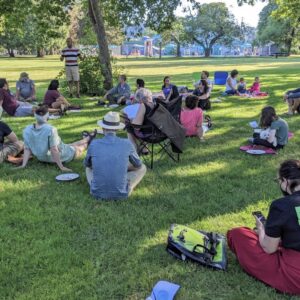

Thanks for reading.
BikePortland has served this community with independent community journalism since 2005. We rely on subscriptions from readers like you to survive. Your financial support is vital in keeping this valuable resource alive and well.
Please subscribe today to strengthen and expand our work.
I’m not sure why people keep saying there’s no room for bus lanes and bike lanes. This appears to be another Hawthorne situation, where what this is REALLY about is preserving the center turn lane for single-occupancy vehicle level of service.
According to PBOT, 82nd Ave is 56 feet wide at its narrowest points (NOT including sidewalks):
It’s trivially easy to design a street that includes both protected bike lanes, bus lanes, AND trees if you get rid of the center turn lane.
(Note that there are no sidewalks in this Streetmix image but that the 56′ ROW measurement is curb to curb, so there would still be space for sidewalks if this design were built).
Btw, Streetmix says that the throughput of bus lanes + center turn lane is 13,000 people/hr, while the throughput with bus lanes + protected bike lanes is 37,000 people/hr. Literally almost 3x more throughput! But god forbid people in cars have to wait slightly longer to turn.
Would there then be no left turns on 82nd at any intersection? Eliminating the mid block turn lane seems fine, but what about the intersections? Would all cars be forced to make 3 rights around the block to go left off 82nd?
To be clear, I’m in favor of adding bus and protected bike lanes to 82nd, just trying to understand the argument that there is currently enough space to do so. Seems to me that you either give up left turns altogether or widen the intersection footprints. Both options seem politically infeasible. And reworking the size of the intersections would cost money that PBOT currently does not have.
Great question.
Yes, you could ban left turns at some/most intersections, and replace the median with left turn pockets at key intersections with lots of turning demand. This is exactly what PBOT does on W Burnside.
You could even allow left turns at all intersections, and drivers would just have to wait for other drivers to turn, just like how it works on, say, SE Stark.
I’m sure there are other solutions here. The point is, there are lots of possibilities if you don’t prioritize moving cars as fast as possible over safety.
“But,” PBOT engineers trained on Robert Moses-era urban planning will say, “that would result in unacceptable backups for cars—in some cases for multiple blocks.”
But those drivers could choose to take public transit or e-bike instead, which, thanks to protected bike lanes and bus lanes, will now be much safer, faster, and more convenient than driving on this route. Even if only 20% of drivers do that, that’s a significant reduction in traffic.
That’s the long game that’s so necessary—reducing mode share by making biking and transit as fast, safe, and convenient [1] as possible. PBOT needs Mapps’ leadership here to achieve this.
[1] http://www.aviewfromthecyclepath.com/2015/05/the-grid-most-important-enabler-of-mass.html
Prohibiting left turns along a roadway is a classic highway-centric design, very often used to enable high-speed long-distance traffic flow by removing any “friction” from turning vehicles. It’s also a good way to really destroy the business community. So I think that would be counter-productive. As for allowing drivers to just turn from the through lane permissively across opposing traffic, that’s how most major streets work in Los Angeles and it is a safety nightmare and sucks for everyone. I think the center lane needs to remain to allow left turns at key locations, and a tree-lined median makes sense where left turns are not needed.
The reason those left turns in LA are so dangerous is because the streets are designed like highways, so cars are driving super fast. With sufficient traffic calming, left turns across opposing traffic on 82nd would be relatively safe. The street should not be designed like a highway, because the actual highway is just a few blocks over.
“But those drivers could choose to take public transit or e-bike instead, which, thanks to protected bike lanes and bus lanes, will now be much safer, faster, and more convenient than driving on this route.”
In other words, “build it and they will come”. Or not.
If folks in that community like your plan, I’d support them.
Or you can build traffic circles and roundabouts.
I don’t see any sidewalk improvements (widening)in your cross-section. Let’s not forget that Line 72 is the highest ridership bus line in TriMet’s network, and the walking environment is much more key to people using transit than bike lanes; most regular transit riders walk to transit. Therefore, I’d rather see wider sidewalks on 82nd Ave; Have you ever waited for the Line 72 on curbtight-sidewalks? It’s frankly an inhospitable environment- it’s loud and dangerous, and there’s often no shelter (trees or bus shelter).
I live right off 82nd Ave and cycle on parallel facilities nearly daily. Sharrows are currently being installed on 80th (I can hear it from my home) as part of the 70s greenway. I sound like a broken record, but we really need well protected and well connected parallel facilities with good access to 82nd.
Again, a false tradeoff. The sidewalks can be widened without encroaching on the ROW!
Zach, I think this graphic is saying sidewalks can be widened ONLY IF private property owners agree to that and, even if they do agree, we would likely need to wait for redevelopment. I think it is work pushing to reduce road width now to create a planting strip that buffers the sidewalks from the traffic and allows the sidewalk to be widened without relying on and waiting for private property. Bike lanes on 82nd would be fantastic, but I think a robust comfortable and safe pedestrian environment would be the #1 most important thing this project could achieve. Unfortunately, it does not look like PBOT plans to include sidewalks (beyond the existing 4′-6′ curbtight sidewalk with new ADA ramps OR bike lanes. PBOT has basically decided that the existing curb is not moving, so this “redesign” is more of a finesse. I think the talk about pedestrians, trees and bikes is typical PBOT “listening” that does not result in actual amenities
Bike lanes aren’t a nice-to-have, they’re essential safety infrastructure like sidewalks. Fortunately, sidewalks already exist on this street, and wider sidewalks, while nice, aren’t essential. People in wheelchairs and mobility devices would use the bike lane, as they do in the Netherlands. The ability to walk three abreast isn’t more important than safety for people biking and rolling.
Only someone who has not walked along 82nd could make this claim.
When are you launching the AI-enhanced Healthier 82nd campaign, Zach?
The reason 82nd is currently so unpleasant to walk on is because you’re mere inches from cars and trucks that are going 50+ mph.
Would be significantly more pleasant next to a protected bike lane.
Here’s some AI to prove it 🙂
It’s darkly comical that you describe an exceptionally narrow sidewalk with multiple utility poles in the middle of the right of way as “pleasant”.
Good luck with the “Healthier 82nd” campaign! I’m sure APANO-Jade District staff can’t wait to hear your ideas.
“People in wheelchairs and mobility devices would use the bike lane…:” That’s a horrible solution for those people AND people biking. It should be obvious to anyone in 2023 that people using wheelchairs or mobility devices should be able to use the sidewalk like anyone else. And they should be able to use it with at least one other person they may be with able to walk alongside them.
Saying they can use the bike lane isn’t much better than saying they can use the sidewalk during off-hours when there’s more room for them.
In my neighborhood people in wheelchairs use the bike lanes and they love it! I can see why as sidewalks often include many hazards to wheelchair traffic, such as families doing their thing, leaf blowers, errant dogs and more.
Also, not that it’s a bad thing that Line 72 is the highest ridership bus, but protected bike lanes would relieve some of that stress and make riding the bus more comfortable for people who want to/need to take the bus. There are lots of able-bodied people who take the bus because they have no other choice (e.g. they don’t own a car and don’t feel comfortable mixing with cars on greenways—most of my friends in Portland are like this) and would gladly zip down 82nd on an e-bike if it were safe. From Powell to Sandy is only 4.4 miles, or a 15-20 minute e-bike ride.
I don’t drive due to different disabilities and definitely rely on public transportation, walking and biking around. Even did so when I lived in Virginia but access to a bus was unfair policy of getting reduced fare so I never got hrt(Hampton Roads Transit) reduced fare pass when I lived in Virginia Beach. I’ve been enjoying using biketown since April last year and almost have over 300 rides. Some bikes were screwed up so I couldn’t ride some.
You’re speculating on a small number of what your friends might do. that’s… speculation. I would suggest consulting ridership data instead about how people actually travel on 82nd via transit. For instance, they’re not just riding N-S along 82nd (your example). Line 72 is frequently used as one leg of a longer trip, so someone is transferring to/from one of the 20 transit lines crossing 82nd. The idea that bike lanes on 82nd Ave would provide an alternative to their trip, as you suggest, is a false one.
Speeding up transit on 82nd (dedicated lanes, stop consolidation, signal priority, all-door boarding) would make transit on 82nd faster, more comfortable, and hence more competitive/appealing as a mode. You seem focused on your able-bodied friends who can afford an e-bike. Many Line 72 riders are low-income and can’t afford an e-bike.
There should be a lot more data available soon re: travel along on 82nd/Line 72 as part of Metro’s 82nd Ave Project. I’m staying tuned for that.
BIKETOWN is free of charge to low-income people and others. I personally signed up disabled houseless people to that service and they loved it!
Why can’t you friends zip along a parallel route? It’s what I do when I ride through that area, and it’s much more pleasant than riding on a route with heavy traffic.
72 ain’t a joke to go on. Bumpy roads indeed. Going down to Clackamas has some smaller sidewalks. Walked on one last week and felt really unsafe. Making my anxiety and panic a little off chart. I frequent line 72 a lot. More so over here then down to Clackamas or the other way. I’m more closer to line 9 and green line.
As someone who lives, walks, and bikes around the area, I’m fine with no bike lanes on 82nd, as long as PBOT gets serious about building up 80th/81st as a parallel bikeway. I noticed they envisioned a bike bridge over the Banfield at 80th, which is a positive thing. But they’ll need to figure out how to get a bike crossing along/through McDaniel High School and Glenhaven Park, and across PCC SE campus, to make 80th really work as a useful parallel route.
Yeah, PBOT could make room for 5′ bikeways along 82nd if they sacrificed the median. Personally, I’d rather keep the median for a bunch of pedestrian safety islands and maybe trees in the middle of the street.
A 6-foot median can easily fit in a 60 foot right of way. PBOT pretends there are a bunch of “hard tradeoffs” necessary because they want to maximize throughput for SOVs, but none of these tradeoffs are actually necessary. You can even fit a 3′ median in the 56′ design if you narrow the bike lanes a bit.
(Note this picture should say 60′ ROW)
Is a 10′ lane wide enough for an FX bus line? The bus itself is 8.5 feet wide, and the side mirrors protrude further. The diagram itself is just for example, of course, but it shows the bus mirrors extending into the adjoining lane and the street trees.
Yes, it is. If you wanted to add some more space, you could make the driving lane 9.5 feet.
yikes! A 2′ planting strip is totally useless- please do not advocate for this. This section also lacks sidewalks.
Here’s the 56′ design with a 3′ median
Again, you didn’t show any sidewalks!
Zach, none of those tree planting spaces is adequate. A 2′ planter includes a 6″ curb, and the 3′ planter includes (2) 6″ curbs. 18″/24″ wide planting spaces will not support a healthy tree. Only the smallest species could survive their, and a small species would be terrible along 82nd. A tree canopy needs to be 7′ above a sidewalk/bike lane and 14′ above a street. Basically, the trees shown in the StreetMix section are impossible. If trees survived at all (unlikely), the best case scenario is shown in the attached edit. No meaningful canopy, low-branches needing regular pruning- more trouble than it is worth.
I am not saying this because a don’t appreciate street trees- I honestly think it would be worth trading in the bike lanes to create 4′ minimum tree planting areas and widen sidewalks.
I’m fine with no car lanes on 82nd, as long as PBOT gets serious about building up 80th/81st as a parallel carway.
I see what you did there, David.
“Our sidewalks are our streets.”
A few years ago, the plan for the 70s greenway had the bike route stay nice and consistent and stay on 80th from Montavilla all the way up to Halsey, with a pedestrian island and beacon at Glisan. THEN they went and messed with things and got creative with the route, making it jog west north of Glisan, on NE Oregon. NOW, it heads west on Everett at Vestal Elementary, heads north and crosses Glisan on 78th, then zigs west at pacific, and north at 76th. Basically they combined it into another greenway, and made it even more confusing.
There’s a map of the new route here, I think PBOT changed the map orientation to further confuse people about how bad the route is, and about how far it deviates from 82nd.
The local PTA, and many others, are hopeful some of the 82nd ave $$ can be used to fund the previously-planned for crossing at 80th and Glisan.
A clear and consistent route along 80th is needed that parallels 82nd up to the 82nd Ave transit center.
New route map, red is the previous route they’re no longer doing:
Old/original route that made perfect sense for being a “parallel to 82nd” bike route.
Just so you know, the maps at the open house showed exactly this route on 80th Ave as a proposed new neighborhood greenway, in addition to the one further west that is being installed now. So you may get your wish!
Thanks for the update, as I was unable to attend. This is amazing to hear, but I’ll believe it when I see it! I did hear they may be waiting for the Halsey St Safety and Access to Transit project to finish, before trying to tie 80th into it. That project will give Halsey a road diet, “mini-roundabout” and a 2-way bike lane OVER 82nd, and all the way to 92nd! Plus better connection from 81st to the 82nd MAX station.
This whole area of 82nd needs some work so hopefully they’re taking the time to fund it and do things right.
https://www.portland.gov/transportation/pbot-projects/construction/ne-halsey-street-safety-and-access-transit-project-ne
The map at the open house also showed a potential bike crossing over the Banfield at 80th, which is something I haven’t seen proposed in the past.
Put in that bridge, and create a bike crossing over the PCC campus at 80th, and there’s the prospect of an 79th/80th Avenue greenway from SE Cooper Street to NE Thompson.
The path could continue even further north if the route jogged over to a two-way cycle track on the west side of 82nd along the high school campus, then onto a bike path across Glenhaven Park to get back to 80th. If that happened, the bikeway could go all the way to Alberta.
SE 80th from Halsey to Hawthorne would be nice!
Yes! 80th is such a great route, all the way from Multnomah down to PCC. Tie it into Halsey, and make the difficult connections safer (Glisan, Burnside, Stark/Washington) and you’ve got an even better route. 80th is wide, straight and a simple alternative to 82nd. This whole new zig-zag from Everett up to 74th @ 84 just doesn’t make much sense, and likely won’t get the love that 80th could, and should!
Interim route that they scrapped. I think they were trying to save $ on the added greenway north of Everett. Instead of having two routes that make sense there’s the current, confusing zig-zag route.
You should generally ignore the city’s Greenway plan and just take the logical route.
I usually do that, but in this case would appreciate the attempts at traffic calming and such that PBOT does for greenways, in addition to an improved crossing at NE Glisan and 80th.
I grew up in East Portland and now live in the East Bay in California.
Out here, we opened a BRT line on International Blvd in Oakland in 2020. Before construction, the road was one of the highest-injury corridors in the city; during construction, the added congestion drastically reduced that.
However, after opening, the road has quickly become *the* most deadly in the city. People routinely swing out into the bus lane and race past traffic, crashing into crossing pedestrians and other cars.
The city and others are now spending tens of millions to retrofit the bus lane with barriers to prevent this kind of opportunistic swinging out from the general use lane into the bus lane.
It’ll be less of a problem on a right-side bus and turn lane, but I’d still strongly, strongly recommend that a curb is put in anywhere feasible along the corridor if bus lanes are installed, and would recommend everyone here push for the same from PBOT.
https://www.google.com/maps/@37.7876372,-122.2431169,3a,64.3y,93.92h,69.09t/data=!3m6!1e1!3m4!1s3Zfdwg7n9GP90nuMPsK7aA!2e0!7i16384!8i8192?entry=ttu
Yeah BMW guy was in the right lane, went left with traffic to pass the semi that was STOPPED IN THE BRT LANE(?!) and then when the google car pulled over to the right lane the BMW floored it. Two lanes bad!
https://maps.app.goo.gl/QrTqxWtoHWSYStiv8?g_st=ic
What a great example of design affordance – the ironclad rule that explains all behavior and states that what ever a design affords (allows) determines how people will use it. So if you allow drivers to access the bus lane – even after you have TOLD them they can’t (the fatal flaw in most Portland designs) – they will access it.
Car-driver behavior is especially pernicious b/c people feel so empowered by their cars that they will do almost anything to shorten their trip, and in fact entire classes of vehicles (like big trucks) are predicated on allowing their users to OVERCOME road designs that would otherwise stop them from doing stupid and dangerous things.
BikeLoud PDX’s ongoing lawsuit against the City of Portland identifies 22 different street construction projects where the city failed to install bike infrastructure as required by state law. And here we see another major reconstruction with no dedicated bicycle facilities.
It’s difficult to see how the city can reach its goal of creating neighborhoods where 80 percent of residents can easily walk or cycle to meet their daily non-work needs, let alone reducing per capita vehicle miles traveled by 30 percent, without getting serious about building dedicated bicycle infrastructure on major commercial streets.
Given PBOT’s current budget crisis, you’d think they would prioritize bike infrastructure as one of the most cost-effective ways to move people throughout the city. Of course, that’s only if you look at the overall cost to society, which no local or state government agency is directly responsible for. Very convenient indeed.
Repaving is not reconstruction. The Bike Bill does not apply to projects whose sole purpose is to provide a smooth surface on the roadway. That’s in the statute, if I remember correctly.
And parallel routes meet the requirements of the bike bill according to legal precedent.
All BS. The standard should be equal infrastructure, everywhere. Otherwise it’s too easy for PBOT to say, “There’s your shitty bike street – over there.”
I agree that it’s BS but that does not change the reality of how the courts interpreted the law.
This has been debunked. Curbs, changed intersections, platforms and infrastructure are not repaving.
PBOT is trying to have it both ways:
reconstruct(oops) repave it! The public outreach boards about pedestrians, street trees and bikes are what PBOT wishes it could do (wink, wink) but cannot, because- repaving.“The community still wants/needs to drive” might be news to those East Portland residents who are too old, poor, or disabled to drive. Or are those groups not considered real members of the community?
“Many people who depend on active travel – lower income families, immigrants, those without cars – choose to live in East Portland for its lower housing costs, and must walk, bike or wait for the bus in substandard conditions.”
“Significant concentrations of zero-car households are found along the MAX Blue Line, often in the form of senior housing.”
“Children and older adults are more likely to rely on active transportation because of age or health-related limits on driving cars. Persons with lower incomes are more likely to use active transportation, as are households without cars.”
https://www.portland.gov/transportation/planning/documents/east-portland-motion-final-report/download
I will support what the community wants to do. If they want bus lanes and bike lines, great. If they want keep the street profile as it is, I’m okay with that as well. I’m an outsider there, and it’s not my place to tell them what to do.
Leaving aside the fact that a public right-of-way is meant to be used (and paid for) by the public at large, who exactly do you mean by “the community”? And how do you proposed to determine what they want?
To me, the community includes the people who live in the area and own the businesses along the street; i.e. those who have to live with it and are impacted most by it. Of course those with “skin in the game” should have a louder voice than folks like me who use the street one or twice per year.
Given the importance of the street as a transportation corridor, I’d also probably give more weight to those who travel along the street than I would on a less significant route.
So business owners are the ones with the most skin in the game? What about low-wage workers at those businesses? Or customers trying to reach those businesses by foot or bicycle? Are they not vastly more impacted by the street design than a local homeowner who has to wait in traffic 30 seconds more per trip?
It’s so very cool that we have a spokesperson for lower-income families and immigrants on bike portland. Just another sign of how the bike scene in PDX is becoming more diverse and open to different perspectives.
Agreed. And just to make sure their voice is heard, I’m going to speak for them too.
Right now they want some ice cream.
I have spent a lot of time thinking about 82nd ave. I share the view that it’s okay if they prioritize better sidewalks and dedicated bus lanes over building bike lanes.
Here’s my two cents;
PBOT/Trimet have burned a lot of political capital doing very unpopular projects in the last few years. As an example, people are absolutely losing their minds over the Division upgrades. For what it’s worth, I personally think they are great. My bus commute sped up 25%, I use the bike lanes a ton, and I even feel safer driving my car on it. That’s not popular opinion though. The unfortunate reality is that not many people are currently using those bike lanes. While I see more and more people on them as time goes on, I suspect it will be a few years before there’s an appreciable volume of bike traffic on Division.
People see that the street is more complicated (humans hate change) ,connect that with empty bike lanes and feel personally attacked because they’re “just trying to drive to x”. The harm that cars cause to our city is a huge gap in perspective for even a lot of very progressive people. In the same way that politicians, like Rene Gonzales, espousing anti-homeless/law and order rhetoric did well in the last election, I fear that it’s only a matter of time before Portland elects a “rip out the bike lanes” mayor.
I see a huge practical benefit in making big transit and safety improvements while still taking into account how the street is currently used – which is overwhelmingly by cars.
Speaking of how the street is used – take a cruise down 82nd on the 72 some day. Or just look at Google Maps. Most properties are explicitly car-oriented development. Many businesses are fronted by large parking lots and drive-thrus. It’s lousy with car dealerships and auto shops too. These are already cause a lot of conflicts for people walking. “Protected” bike lanes would have to have frequent and large gaps to accommodate access to the properties along the street.
If I was redoing 82nd in my Cities:Skylines game I’d just delete the car-oriented stuff and replace it with mixed-use buildings that front to the sidewalk. I’m sure that will happen in real life, but it will take decades if not a generation. The city can’t just cut off access to all those business – even if the commenters on Jonathan Maus dot com think they should be able to.
Upgrading sidewalks and transit service will have a tangible and immediate benefit to the people who are already using the street outside of a car. Upgrading parallel greenways with diverters and crossings is a great solution to provide bike access and another sorely-needed North/South bike connection.
Sometimes we have to compromise projects we should build in order to get projects we can build.
That’s a great point about all the driveways on 82nd Ave. A “protected” bike lane would not actually be all that protected if there are constant gaps to allow turning vehicles. It wouldn’t feel very safe or comfortable, or all-ages. So we really need the land uses to transform to get fewer driveways before it would even make sense.
A raised, sidewalk-level bike lane (along with raised crosswalks) would dramatically increase bicyclist comfort by forcing drivers to slow down when entering & exiting parking lots. This would also make it easier for pedestrians (including wheelchair users) by making the sidewalk completely flat, with no dipping down to street level.
https://nacto.org/publication/urban-bikeway-design-guide/cycle-tracks/raised-cycle-tracks/
I don’t know if this is still the case, but in the 2010s certain sections of 82nd were some of the few sections of the city that street walkers were not harassed by police or chased out by neighborhood associations. It may not be a particularly wholesome business, even rather seedy and exploitative, but such people need to make a living somewhere, and as in the Netherlands, each community needs to figure out where it will allow its red light district to exist.
I’m not sure if you’re being facetious or not. I’m fairly certain most sex work is organized online these days.
There are prostitutes out on 82nd Ave, mostly north of I-84, every day and every night. It’s a thriving business, and is not being conducted online. It’s very much out in the open.
People in SW Portland similarly “lost their minds” about the two “rose lanes” (dedicated bus lanes) in Hillsdale.
Guess what? Hasn’t made any appreciable difference in travel times for drivers, but boy oh boy have the bus-transit times improved.
And that should be our priority: let’s put the needs of the many in buses over the individuals in cars who are destroying the planet to reach their destination 30 seconds faster.
I think the situation in Hillsdale is a bit different. Division is a very big and noticeable project. It was also originally sold as having street trees in the median. Thanks to the water/sewer main under the street they had to quietly nix the trees in order to avoid spending a boatload over budget to relocate the buried infrastructure. While the rest of it is mostly “as promised”, many in the public are fixated on the lack of trees, and the city, for their part, didn’t do a very good job of communicating why they didn’t put trees in.
People are slow to change & slow to adapt to change. To use just one example of how slow, Google is telling that Ruby Bridges is only 68.
To use your example of Division, it’s been kind of an awkward street ever since I have been riding in Portland. It curves, and it runs parallel to railroad tracks. It’s wide in some parts, but not in others. People speed up and down it. Even with bike lanes added, it seems difficult. Thinking back to last time I rode there, I don’t quite remember if the bike lanes go all along the street. Having been forced to find other routes for so long, a lot of riders are probably just used to avoiding Division.
I have not been to 82nd in awhile, but I do remember it being much as you describe: a very wide street, full of car dealerships, drive throughs, and broken sidewalks. Fixing the sidewalks, and upgrading pedestrian facilities would go a long way towards improving things on 82nd. I don’t remember any ever suggesting “just cutting off access” to any businesses. If anything, improving pedestrian, and bike facilities along 82nd would increase access to businesses.
Just one correction: the stretch of roadway from Alberta to Lombard actually was transferred from ODOT to PBOT. But ODOT still owns the two traffic signals in that stretch, and they still own the “other” 82nd Ave that goes up to the airport.
In regard to the question about what sort of transit this will have — let’s put in a streetcar line!!
That would be cool. But only if there’s no parking next to it and it gets signal priority.
EDIT: I could see that being a pretty monumental investment though. The current streetcar barn is in NW under 405, so you’d need to either build a completely different system on 82nd, or build tracks from the Central Eastside out to there. Maybe go big and run the streetcar on Sandy as well?
It would make much more sense to run high-capacity transit (i.e. MAX) along this street, adjacent to housing, shopping, and employment, instead of next to the 205 freeway. So many missed opportunities for actual transit-oriented development there.
$185M
Data showing need to reduce VMT by 2030 due to climate collapse
Data showing protected bike lanes are the only solution to increase ridership and safety
A State law requiring bike infrastructure on all road construction
And we get zippo.
I think we can all now clearly state that this whole bike effort thing is a charade.
Better to leave PDX than try to fix this mess, after all this time.
Because it’s soooo much better elsewhere throughout the country…
Our passive response to government reminds me of the voice on the beg buttons that say “Wait.”
Wait…
Wait…
Wait…
And eventually the light will turn green, we’ll get our walk symbol for a few seconds, then a 20-second red don’t walk countdown, as cars once again dominate the stroadway and we are back to where we started, waiting.
Or we can become proactive and be the change agents in our government.
It’s all about choice.
The only solution?
Show me your “data”.
If they don’t build any bike facilities, wouldn’t that be a violation of the Bicycle bill?
Not if they provide an adequate parallel route, as described in the law.
In the workshop comments, I see the eternal struggle of transit. Transit dependent users tend to plan around a schedule and want expedited trips. Other people, ie the wonks, want short headways for spontaneous trips. One group wants to fly, the other wants to drive, and if we can’t have both I’ll just say that MAX and even the bus have more in common with a 737 than a Prius.
My father spent his last years in a wheelchair, and my aunt, who helped with his care, is getting to that point. To carry on with the flying analogy, the last I knew airports were only getting bigger, but I don’t think that means they stopped providing everyone with fast, reliable transportation.